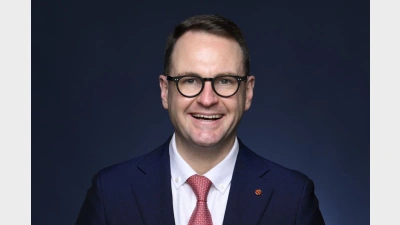Challenges and change
January
The Association of Superannuation Funds of Australia (ASFA) restructured and re-branded its education and training program, remarketing its ‘professional development suite’ as Professional Development Pathways, designed to dovetail with its existing accreditation program.
Seven of Australia’s major public sector superannuation funds expressed concern at the findings of research conducted by BT Financial Group.
Among the most disturbing findings was that directors of around 10 per cent of companies traded during the so-called ‘black-out’ period between the end of a company’s reporting period and the announcement of results.
“The research clearly shows that not all companies are taking director share trading seriously,” said Steve Gibbs, chief executive of one of the funds sponsoring the research, PSS/CSS.
“We want companies to promptly inform the market of the reason behind major sales by directors and executives, and we want to be confident that changes in directors’ and executives’ interests are notified to the market in accordance with the law.”
February
Choice of superannuation fund failed to deliver the accelerated growth of self-managed superannuation funds (SMSFs) that many insiders predicted.
This was confirmed by Australian Taxation Office (ATO) assistant deputy commissioner Ian Read, who said, “The anticipated growth has not eventuated. In the quarter to September, growth rates have slightly declined in comparison to the same period last year”.
While there was a rapid increase in the number of SMSFs being established during 2003 and 2004 to an average of 3,000 per month, this figure declined to around 2,000 per month.
A study by Mercer Investment Consulting warned superannuation fund trustees to rein in their expectations for 2006, after an unprecedented run of double-digit returns in 2005.
According to the survey, global equity markets were expected to achieve a median return of 7.6 per cent, compared to a 9.5 per cent return for the MSCI World IndexSM in 2005, and annualised historical returns of 19.3 per cent for the past three years.
The Australian Securities andInvestments Commission (ASIC) issued a warning to corporate superannuation advisers, reminding them that they must treat all employers equally, regardless of their size.
“We wish to make it clear that no small business, asset value or other size consideration applies,” said ASIC assistant director of compliance Louise du Pre.
Advice to any employer about superannuation was considered advice to a retail client, with the standard client obligations applying across the board.
March
A number of industry commentators noted that the Government’s choice legislation had a much smaller impact than many expected.
Data gathered by the Association of Superannuation Funds of Australia (ASFA) indicated that while 7 per cent of people changed funds, only 4 per cent chose a new fund as a “conscious act of choice”, with 2 per cent going to a new fund because it came with a new job and 1 per cent changing because of the closure of an old employer fund.
It was suggested that these figures could have been very different if the choice legislation had been introduced during a period of poor investment returns by superannuation funds and master trusts.
April
The ATO announced a renewed focus on SMSFs, revealing it had applied over 80 enforceable undertakings to SMSFs by April, with another 100 or so still in progress.
Deputy commissioner of taxation Raelene Vivian said the ATO had wound-up 13 funds and disqualified 15 trustees, with a further six found to be non-complying and seven under consideration for non-compliance.
“To give you an indication of the amount of benefits accessed illegally, so far we’ve found 83 instances where there is around $732,000 in tax shortfall,” said Vivian.
The introduction of the Australian Prudential Regulation Authority’s (APRA’s) Responsible Superannuation Entity (RSE) licensing regime in February this year marked something of a watershed moment for the industry.
The earliest funds that achieved RSE status were predominantly large, though plenty of smaller funds continued providing services to members regardless of the challenge presented by factors such as choice and the new licensing requirements.
Despite the fact that many of the funds that initially applied for the RSE licences were classified as medium to large, advocates such as Bob Hendricks, chair of three smaller Queensland electrical industry funds, believed that there remained a place for ‘boutiques’.
“The benefits with respect to size are well-known, but we should not underestimate the value of a boutique in terms of familiarity.
“In a boutique, members often feel more comfortable in the sense that they know how their fund runs and who to talk to. They aren’t just one of 500,000 members,” he said.
May
According to APRA statistics, superannuation assets increased by 18.5 per cent to the year ending June 30, last year.
Industry funds experienced the largest growth during the year, with assets increasing 27.4 per cent. Comparatively, retail funds grew by 16.9 per cent, public sector funds grew by 14.8 per cent and corporate funds grew by 4 per cent.
Noting the flagging growth experienced by corporate funds, APRA deputy chairman Ross Jones said the new figures showed the accelerated progress of consolidation in the industry, which resulted in a contraction in the number of service providers engaged by trustees.
“In particular, an increasing proportion of trustees are using fewer custodians, audit firms and investment managers,” he said.
Superannuation member education was another flavour of 2006, with numerous studies indicating Australians’ understanding of financial matters, including retirement planning and superannuation, was worryingly deficient.
A finding of the annual Conference of major Superannuation Providers in April was that financial education was narrowing the gap between Australians’ retirement expectations and what their current superannuation arrangements would actually deliver.
UniSuper’s joint research with Deakin University demonstrated an example of this, finding a 100 per cent improvement rate in respondents after their attendance at a specially arranged seminar.
“We can say with confidence that the financial education seminars inspired significant change in our members’ perceptions and understanding in all key areas,” said UniSuper chief executive Anne Byrne.
June
When the Federal Treasurer, Peter Costello, delivered this year’s Budget, the superannuation industry got more than it bargained for.
The removal of the withdrawals tax caught the industry by surprise, with most stakeholders having instead campaigned hard for the abolition of the 15 per cent contributions tax.
Describing it as a “simplification and streamlining” of the superannuation system, Costello announced a removal of the benefits tax on superannuation for people aged 60 and over from July 1, 2007, plus abolition of the reasonable benefit limits (RBLs).
These changes were rubberstamped by key industry representatives, with both ASFA and the Investment and Financial Services Association (IFSA) lauding the Budget, despite the fact it had not delivered on their core request for the abolition of the contributions tax.
Much was made during the year about the rampant underinsurance of the Australian population.
IUS Life general manager of insurer Phil Collins said, “It is quite clear that a high proportion of people do not have enough insurance coverage to protect them and/or their families against death or disability”.
He said rather than using salary increases to fund insurance to protect assets and income, most Australians are “living for the moment”, using additional income to finance greater debt in purchasing items such as new cars, funding renovations or installing a swimming pool.
July
In the wake of the more stringent licensing requirements imposed by APRA, ASFA criticised the regulator for imposing higher fees and charges on those funds remaining under its control.
With the number of trustee entities remaining under the licensing jurisdiction falling to 307, ASFA chief executive Philippa Smith confirmed that superannuation funds faced hefty increases in the levies they are obliged to pay APRA to help fund its activities.
“Their [APRA’s] preferred model would have seen a 100 per cent rise, but after some discussion I believe that is being reduced,” she said.
Superannuation fund chief executives Neil Cassidy, of Tasplan, and Ian Silk, of AustralianSuper, acknowledged the levy increases and believed they needed to be reviewed further.
August
The scalp of AMP Financial Planning was claimed by ASIC in its ongoing monitoring of superannuation switching advice.
ASIC imposed an enforceable undertaking on the high profile planning dealer group after a review of 300 client files discovered some AMP financial planners had not disclosed a reasonable basis for advice when recommending a change in superannuation funds.
AMP accepted the ruling, stating that “in some cases, the reasons for recommending changes to superannuation arrangements were not as well documented as they needed to be”, according to AMP chief executive Andrew Mohl.
The fees versus commissions debate continued as the superannuation industry digested changes brought about by the choice of fund legislation.
Competition between master trusts and industry funds after the advertising campaign launched by industry funds sparked debate over the payment structure of financial planners.
Labelling the fees versus commissions debate a null issue, many argued the key issue should be transparency, regardless of which remuneration method was adopted by the provider of advice.
September
With superannuation fund trustees expressing greater interest than ever in infrastructure investment, ASFA, in a submission to the Department of Prime Minister and Cabinet, pointed out that the asset class presented particular challenges.
The submission said infrastructure investments had their own legal and financial complexity that required government to ensure a simple, coherent and transparent framework.
ASFA director of policy and research Dr Michaela Anderson pointed out “increasing demand for water is highly likely”, which could fuel greater investment in water supply and wastewater services.
According to the submission, “Governments at all levels may play a role in aggregating such opportunities to make them more viable”.
Superannuation assets climbed over the $900 billion mark to reach $913.9 billion, according to data released by APRA, increasing by over 19 per cent in the 12 months to June.
Industry funds increased by 3 per cent, retail funds by 2 per cent and public sector fund assets jumped by 0.7 per cent.
It also pointed out that consolidation of the corporate superannuation sector continued, with assets held by corporate superannuation funds decreasing by 7.6 per cent during the June quarter.
Retail funds remained in their dominating position, accounting for 32.3 per cent of total assets held, followed by self-managed superannuation funds with 23 per cent and industry funds on 16.9 per cent.
October
ASIC warned that it would be closely monitoring the timing and content of the superannuation industry’s disclosure to members who transfer out of funds without their consent.
“ASIC will specifically look at the timing of disclosures made and whether opt-in or opt-out provisions dictate members’ transfers,” said ASIC chairman Jeffrey Lucy.
While pointing out ASIC’s role was not to vet product disclosure statements, he said the length of some remained a concern.
Prominent international fixed interest company PIMCO expressed its belief that the United States’ housing slowdown posed a significant risk for investors globally.
At its quarterly cyclical forum held in late September, issues addressed included whether the US economy would experience a hard or soft landing, with PIMCO taking the line that it would be a soft landing.
PIMCO managing director, portfolio management, Paul McCulley said “the recession in the US housing sector … will be nastier than expected, both directly in terms of residential investment and indirectly via the effect on consumption”.
November
A report published by Mercer Investment Consulting warned that institutional investors needed to closely examine their exposure to hedge funds, with questions asked about the sustainability of returns.
The report pointed out that with more than 9,000 funds collectively investing more than US$1.1 trillion, investors seemed willing to compromise on fees, transparency and liquidity in return for the promise of desirable absolute returns.
“When assessing fund of hedge funds, investors will need to examine the breadth of strategies employed, whether strong operational and investment due diligence teams exist and whether risk management is undertaken on a transparent basis,” it said.
Recommended for you
Future Group is set to take on nearly $1 billion in funds under management (FUM) and welcome more than 100,000 new members following two significant successor fund transfers.
Insignia’s Master Trust business suffered a 1.9 per cent dip in FUA in the third quarter, amid total net outflows of $1.8 billion.
While the Liberal senator has accused super funds of locking everyday Australians out of the housing market, industry advocates say the Coalition’s policy would only push home ownership further out of reach.
Australia’s largest superannuation fund has confirmed all members who had funds stolen during the recent cyber fraud crime have been reimbursed.












